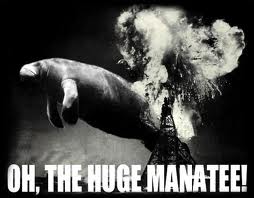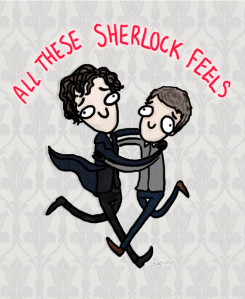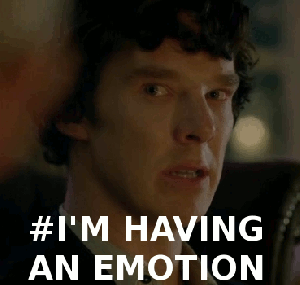Dr Jem Bloomfield is an academic, playwright and critic, with particular expertise in early modern theatre. His PhD was on the production history of John Webster’s Duchess of Malfi. He is the author of the quiteirregular blog. Here Jem discusses the new use of the word ‘feels’ to mean, well… what exactly?
I forget which of my friends suggested that “this new use of the word ‘feels’ instead of ‘emotions’” could usefully “die in a fire” as soon as feasible. If I’ve come across it enough to recognize what they were referring to, I suspect the term is hopelessly old hat on the internet. Possibly even as old hat as saying “old hat”, a phrase which has ironically become obsolete due to the fashion for old hats brought on by steampunk or neo-Victorianism or cold ears or some such. But you do see a lot of “feels” on display online these days. The announcement of a new Doctor Who, or Frances Barber’s casting in Julius Caesar, or the discovery that Britten and Auden collaborated on an adaptation of The Duchess of Malfi, have been known to lead to declarations that I HAVE ALL THE FEELS UPON THIS SUBJECT.
At first sight this term does appear to be a candidate for arson-related demise. As the comments at Know Your Meme have pointed out, it is apparently redundant, childish and an imprecise stand-in for “emotions”. It also has the potential to be intensely irritating. However, I wonder whether it might be a more useful term than it appears. The emphasis in memes and phrases on the inability of the speaker to process or articulate their “feels” reminded me of the stress on “affect” in various parts of the humanities. Felicity Callard and Constantia Papoulias have distinguished between “emotion”, a defined and structured state which can be labelled and compared to other incidents or other people’s emotions, and “affect”, the immediate physical experience which we later try to process and fit into the known “emotions”. For them “affect” is a bodily event, a surge of physical processes felt not in the mind but in the gut, along the skin and between the muscles. In their phrase “an ‘affective event’ is not consciously apprehended, but is, rather, what happens to the body directly on the level of its endocrinology, skin conduction, and viscera”.
Callard and Papoulias are interested in the way “affect” may help to break down the unhelpfully rigid distinctions between mind and body which the Cartesian tradition imposes, allowing us to concentrate on the “immediacy of embodied experience” and the ways in which we engage with the world beyond identifying or representing parts of it. When talking about art, we might find it useful to keep this category open as well, and not foreclose it too hastily by fitting it into pre-existing “emotions” which everyone has apparently agreed people are allowed to feel. I don’t know how it feels over in sculpture or music, but my reactions to a performance are frequently a visceral jumble of criss-crossing exhilarations, queasinesses, desires and shivers. They can’t even be called “conflicting” or “mixed emotions” because it isn’t clear how they might be opposed to each other, or what aspects of the performance each might be responding to.
I’m not suggesting we shouldn’t move to articulate, analyze and examine these responses: FEELS is not a satisfying final conclusion. But spending more time in the “feels” phase might well alert us to aspects of the aesthetic experience which we might otherwise overlook or distort whilst identifying emotional states. Counter-eddies, background impressions and ambivalences may come to the fore which can give us a richer account of our engagement with an artistic work – and with the world more generally. After all, I don’t usually experience a piece of music as a set of formal structures, or a set of associated recognizable emotional states. The last time I watched a play my mind didn’t seem to apprehend particular emotions being created onstage and instruct my body to react in compliance with the information. At least, that’s not how I experienced it. Rather it was my body – my lungs, my skin, my teeth, my throat – which reacted first, setting up physical states which I could then identify as relating to the content or form of the art work. It’s that pre-analytical state, the mode where you watch the play with your toes and your knuckles, which affect can cover and which we might want to pay attention to.
So, regretfully (because I love a good snarl about words as much as anyone), I think “feels” may have its place. It may be a category which allows us to explore our reactions to shows and rumours of shows in productive ways. But I draw the line at that manatee. If he wants a place in my account of art, he can put a damn top hat on and learn to tapdance.

THE HUGE MANATEE REFUSES TO BE EXCLUDED BY YOUR NARROW CONCEPTUAL FRAMEWORK. THE MANATEE OPERATES ON THE LEVEL OF ENDOCRINOLOGY. ALSO HYDROGEN AND LOLS.
This post first appeared on the quiteirregular blog in February 2013.


